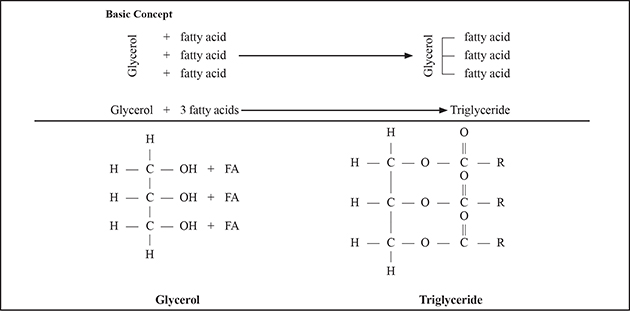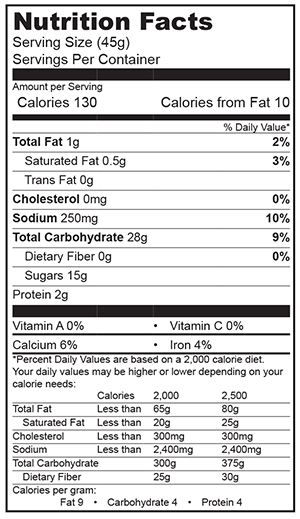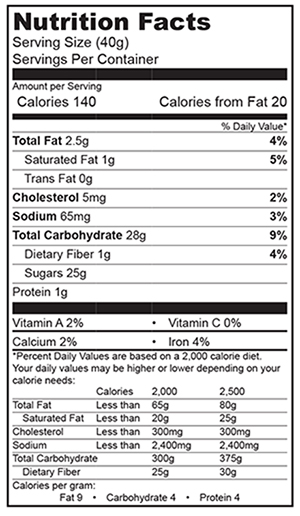G2187
Fats in the Diet
Although fats sometimes are associated with weight gain or health problems, fats aren’t all bad. This publication discusses fats and their roles in the body and in foods. Different types of fats, fat substitutes, and ways to reduce fats in some foods are other topics.
Georgia M. Jones, Extension Food Specialist
- What Are Fats?
- Types of Fatty Acids
- Spreads
- Fat Substitutes
- Simply Delicious Cake
- Chocolate Cream Cheese Frosting
For some people, fat has a negative connotation. However, like all nutrients, fat, in the appropriate amounts, is beneficial and necessary. Fat has many roles in the body and in food products.
Fats are a source of energy for the body and supply essential fatty acids, such as linoleic and linolenic. Fats are required for maintaining healthy skin and regulating cholesterol production. Fats carry the fat-soluble vitamins A, D, E, and K and aid in their absorption from the intestine.
Fats play a key role in determining texture, taste, and flavor of foods and affect the acceptability of food. They provide the smooth texture of salad dressing, the creamy feel of ice cream and chocolate, the moist, tender texture of cakes, the rich flavor of cheese, and the juiciness of meats.
What Are Fats?
Fats are composed mostly of the same three elements as carbohydrates, carbon, hydrogen, and oxygen. Fats are made of a 3-carbon glycerol unit (Figure 1). This is sometimes referred to as the backbone of a fat. Each carbon on the glycerol can hold one fatty acid. Fats supply 9 calories per gram. Carbohydrates and protein supply 4 calories per gram.
 |
Figure 1. A triglyceride (fat) is made of combining three fatty acids with a glycerol molecule. |
Types of Fatty Acids
Saturated Fatty Acids
These fatty acids have all the hydrogen they can hold. They are normally solid at room temperature. Most saturated fatty acids are from animals; however, coconut and palm oils also contain saturated fatty acids. Saturated fatty acids are found in tallow, lard, butter, and solid shortenings, such as Crisco®.
Monounsaturated Fatty Acids
These fatty acids are missing one hydrogen pair. Good sources of monounsaturated fatty acids include olive, canola, and nut oils. They are liquid at room temperature.
Polyunsaturated Fatty Acids
These fatty acids are missing two or more hydrogen pairs. These fats are liquid at room temperature and are usually from plant foods, such as soybean, safflower, cottonseed, or corn oils. Fish oil is also high in polyunsaturated fatty acids.
Trans Fatty Acids
Trans fatty acids are formed during hydrogenation of fat (converting from a liquid to a solid). Trans fatty acids function more like saturated fatty acids, making fats more solid at room temperature. They also are created in oils during frying, especially if the oil is reused. Fried foods and foods prepared with hydrogenated fats are usually high in trans fatty acids. Some research has shown that a high consumption of trans fatty acids is associated with an increased risk of heart disease.
Omega-3 Fatty Acids
Omega-3 fatty acids are found in seafood, such as shellfish, salmon, mullet, and sardines. Flaxseed is a good plant source of omega-3 fatty acids. Eggs with increased levels of omega-3 fatty acids can now be purchased. A diet high in omega-3 fatty acids has been associated with a reduced risk of heart disease. The 2010 Dietary Guidelines for Americans recommends that we consume 8 ounces of a variety of seafood per week. This amount will provide an average consumption of 250mg per day of omega-3 fatty acids.
Conjugated Linoleic Acid (CLA)
Conjugated linoleic acid is a group of polyunsaturated fatty acids found primarily in lamb, beef, and dairy products. CLAs are isomers of linoleic acid, a polyunsaturated omega-6 fatty acid.
Numerous health benefits have been attributed to CLAs. Some animal studies have shown that CLAs reduce the proliferation of certain cancer cells, lower cholesterol levels, reduce the size of lesions found in arteries, and improve the ratio of lean body mass to fat. Although some research has shown CLAs may have a positive effect on health, their role in human metabolism is uncertain.
Spreads
Butter and Margarine
Butter is an animal fat. Margarine is hydrogenated vegetable oil with added color. Butter and stick margarine have 36 calories per serving (about 1 teaspoon). Since butter is an animal product, it does contain cholesterol. Margarine has trans fatty acids as a result of a process known as hydrogenation. Some butter will say “whipped” on the label. This product has added air. One teaspoon of whipped butter has 22 calories per serving. Whipped butter cannot be substituted for regular butter in baking.
There are many different kinds of margarines. Margarine can be purchased in either the tub or stick form. Both can be purchased in the reduced-fat form. Reduced fat margarines generally have added water. Due to the increased water content, reduced-fat margarines cannot be used for frying or baking. Reduced-fat margarines usually are not as hydrogenated as regular margarines.
Plant Stanol and Sterol Esters
In September 2000, the FDA authorized health claims about the role of plant sterol and plant stanol esters in reducing cardiovascular heart disease (CHD) risk. Both substances are present in small amounts in fruits, vegetables, nuts, seeds, cereals, and legumes. Benecol® (plant stanols) and Promise Activ® (plant sterols) are margarines that also contain these esters. Benecol and Promise Activ have demonstrated LDL cholesterol reductions of 14 to 17 percent. Neither product reduces HDL cholesterol or triglycerides levels. Eating two to three servings of one tablespoon each generally will give increased health benefits. Both margarines provide 100 percent of their calories from fat, so use these to replace some of the fat already consumed. There is a light (reduced calorie) version of both products.
Fat Substitutes
Recently, the prevalence of low-fat, reduced-fat, and fat-free foods has increased substantially. Lower-fat foods not only help reduce fat intake but may lower calories as well. When choosing lower-fat foods, read labels carefully. Lower fat does not necessarily mean fewer calories.
The content of fat in some foods is reduced by removal, as in the production of low-fat or fat-free (skim) milk or in the trimming of fat from meats. In baked products, like cakes and pie crust, fat plays an integral role. Simply removing fat from baked products may reduce product acceptance. In this case, a fat substitute may be used. Fat substitutes replace specific attributes of fat in low-fat, reduced-fat, and fat-free foods.
There are three categories of fat substitutes: carbohydrate based, protein based, and fat based.
Carbohydrate-based Fat Substitutes
Carbohydrates act as thickeners, moisturizers, and stabilizers, but they cannot be used as a substitute for fats in frying. Carbohydrate-based ingredients are used in lower-fat and fat-free baked goods, frozen desserts, gravies, processed meats, puddings, salad dressings, sour cream, and yogurt. Fruits and fruit purees, such as applesauce and prunes, can be used as fat substitutes. Carbohydrate-based ingredients provide 0 to 4 calories per gram, depending on the ingredient.
Protein-based Fat Substitutes
Sources of protein-based fat substitutes include soy, whey, and egg white. Protein-based fat substitutes may be found in cheese, butter, mayonnaise, salad dressings, frozen dairy desserts, sour cream, and baked goods. Simplesse® is made from whey or egg whites and is used primarily in frozen dairy desserts. Because protein-based fat substitutes break down when heated, they can be used only in uncooked foods. Protein-based ingredients provide 1 to 4 calories per gram. People allergic to dairy or egg products won’t be able to consume dairy- or egg-based fat replacers.
Fat-based Fat Substitutes
Fat-based substitutes are made to contribute fewer calories or no calories. Fat-based fat replacers are made in two ways: the structure is modified so that the fat is not absorbed as well or the length of the fatty acid on the glycerol is shorter. Because these substitutes are made from fat, they provide the same physical properties as fats, including taste, texture, and mouthfeel. Fat-based substitutes can be used in a variety of foods, such as cheese, confections, sour cream, and baked goods.
Olestra is a fat-based substitute frequently used to make reduced fat potato chips. Olestra is the scientific name and Olean® is the brand name. Olestra is a combination of sucrose and either cottonseed or soybean oil. The olestra molecule is larger than the triglyceride molecule. Instead of having three fatty acids, it has six to eight; therefore, your body cannot digest it. Olestra has been reported to decrease the absorption of vitamins A, D, E, and K so the FDA requires that fat-soluble vitamins be added to it. This product is stable at high temperatures and can be used for frying.
Digestive Effects of Fat Replacers
Fat replacers are not fully absorbed by the body. Overconsumption of fat-based and some carbohydrate-based replacement products may cause abdominal cramping, bloating, flatulence, and loose stools.
Tips for Reducing Fat
- In many recipes, the total fat content can be reduced by one-third. If a recipe uses 1 cup shortening, cut the amount to ⅔ cup. In other recipes, substitute some lower-fat ingredients for higher-fat ingredients. For example, if a recipe calls for sour cream, use reduced-fat sour cream or low-fat yogurt.
- Use lean or extra lean meats; trim visible fat on meat and poultry. Chill gravy, soups, and stews until the fat solidifies on the top, and then lift it off.
- To change the type of fat in a recipe from saturated to mono- or polyunsaturated fat, substitute fat from animal sources with fat from plant sources. This substitution will reduce the cholesterol and saturated fat content, but not overall fat content. Examples of this type of recipe adjustment are substituting a vegetable fat, such as soybean or corn oil, for lard.
- Only animal products contain cholesterol. Egg yolks are one of the richest cholesterol sources. To reduce the cholesterol content of a recipe, use two egg whites in place of one egg. Egg substitutes such as Egg Beaters® and Egg Scramblers® can substitute for eggs in many recipes.
- Applesauce also can be used as a fat replacer. Replace the fat with an equal amount of applesauce. Prune puree can be substituted for ½ of the fat in baked products. If a recipe calls for 1 cup of butter, use ½ cup of butter and ¼ cup of prune puree. Even in baked products, prunes still have a laxative effect.
- To make prune puree, combine 1 cup pitted prunes (6 ounces) and 6 tablespoons hot water. Process in a food processor until smooth. Puree can be stored in the refrigerator for one month. Prune baby food can be used instead of prune puree.
The following recipe is for a reduced-fat cake:
Simply Delicious Cake
Ingredients:
1 box (16.5 ounce) cake mix, yellow or white
1 Tablespoon all-purpose flour
Water
Applesauce
Egg whites
Directions:
- Heat oven to 350°F. Spray cake pans with nonstick cooking spray.
- Add flour to cake mix and stir to combine.
- Add water as directed on package.
- Substitute an equal amount of applesauce for any oil called for in the recipe.
- Use one egg white for each egg called for in the recipe.
- Mix and bake for 25 to 30 minutes. Cool in pans for 10 minutes. Remove and allow cakes to cool completely. Frost cake with chocolate cream cheese frosting.
Chocolate Cream Cheese Frosting
Ingredients:
| ½ block (8 ounce) ⅓ less fat cream cheese 2 Tablespoons stick margarine, softened 3 Tablespoons skim milk 3⅓ cups sifted powdered sugar |
¾ cup unsweetened cocoa ⅛ teaspoon salt 1 teaspoon vanilla |
Directions:
- In a large bowl beat cream cheese, margarine, and skim milk until smooth. Combine sugar, cocoa, and salt; gradually add sugar mixture to cheese mixture, beating at low speed until well-blended.
- Add vanilla and beat well. Cover and chill.
Note: Cake can also be baked in a Bundt pan. Bake at 350°F for 30 to 35 minutes. Serve with whipped topping and fresh fruit. Serves 16.
Simply Delicious Cake |
Chocolate Cream Cheese Frosting |
|
 |
 |
This publication has been peer reviewed.
DisclaimerReference to commercial products or trade names is made with the understanding that no discrimination is intended of those not mentioned and no endorsement by University of Nebraska–Lincoln Extension is implied for those mentioned. |
Visit the University of Nebraska–Lincoln Extension Publications website for more publications.
Index: Foods & Nutrition
Nutritive Value of Foods
Issued July 2013